Marian Młynarski

The "Save the Memory" project is a series of video interviews with witnesses of history from 1939- 1956. It was created to preserve the memories and experiences of the heroes and heroines from this period.
At the beginning of the film. the logos of the Polish History Museum are illustrated, featuring a yellow crown, gray wings, and the letter "P" in red with the Polish flag in the center. Also detailed is the phrase ”Patriotism of Tomorrow” with the letter "P" in black. Underneath these icons, there is a white inscription "Project co-financed by the Museum of Polish History in Warsaw as part of the Patriotism of Tomorrow program."
The main character of the film is Marian Młynarski, born in 1926 in Warsaw. He was a scout in the
Grey Ranks - the youngest age group Zawisza, nicknamed "Zuikis", "Kiškis". After the war, he worked as a museum worker and herpetologist. The man, aged 88, is framed to the chest. He is sitting on a chair in the room, behind him are elongated bookshelves. He has gray hair and a serious expression on his face. He is dressed in a black undershirt, a gray-green shirt, and an ash-colored jacket.
Throughout the film, he shows footage from his private archive, photos of family and friends, and
documents. At the end of the film appears a blackboard with the blue logo of the Historical Museum of the City of Krakow and the white logo of Oskar Schindler's Emalia Factory Lipowa 4. At the bottom is the website address: www.ocalicpamiec.mhk.pl and the year of production - 2013.

Marian Młynarski
1926

Black and white photo of young Marian. A school-aged boy poses for the photo - his face is open and his eyes are squinted. He is dressed in a uniform with a white collar. On his head, he is wearing a flat cap.
Marian Młynarski (born 29 January 1926 in Warsaw), son of Maria (family name Ejsmond) and Feliks. Scout of Szare Szeregi – belonged to the youngest group Zawisza. Pseudonyms: Zuikis, Kiškis. After WWII he was a museum director and herpetologist.
Marian Młynarski started his education at Ziema Mazowiecka School in Warsaw. In 1938 he joined a school scout group (21 company named after Ignacy Prądzyński).
In 1941 he and his mother moved to Kraków to join his father who had accepted the position of president of the Bank Emisyjny. The family lived on Basztowa Street in an apartment in the same building as the bank.
Młynarski continued his education in underground courses and in 1943 took his school finishing exam. At the same time, he studied legally at a secondary chemical school.
In 1943 he joined Zawisza, the youngest section of the underground scout group Szare Szeregi. His particular group Gryf consisted of four people, The group’s leader being Miś (Tadeusz Rokossowski). The boys trained in the Wolski forest and Młynarski earned a Wywiadowca rank. He learned topography and Morse code, collected maps, and learned about the German armed forces and paramilitary organizations.
The exam was combined with the pledge on 23 April 1944 in the Akanta glade behind the Kmita Rock, near Balice. About 40 Zawiszaks took part in it.
The scout group had their meetings at Młynarski’s flat. The flat also served as a shelter for Młynarski’s relatives and friends who escaped from Warsaw after the Warsaw Uprising failed. At times 35 people stayed there. In July, during Operation Tempest, the Home Army (AK) had people swear military oaths on a mass scale in Kraków. The oaths were taken in various places, and many people took them in Młynarski’s apartment.
Młynarski helped to hide and secure collections of the Environment Museum, the Polish Academy of Arts and Sciences, and the Zoology Institute at Kraków’s Jagiellonian University.
On 7 August 1944, following his father’s request, he started work as a courier at Bank Emisyjny delivering bank mail. But he used the opportunity to also deliver underground mail for Szare Szeregi and the Home Army (AK). He carried a gun and was given a special pass which allowed him to travel on Nur für Deutsche (Germans only) trains. He delivered mail to the general governor at Wawel castle, to the seat of the SS commander, and to the police on Oleandry Street.
In September 1944 Młynarski was promoted to the rank of leader of VI Zawisza Team. The team had their meetings in Mr and Mrs Mikułowski’s flat on 8 Krupnicza Street. Młynarski earned the rank of ćwik and harcerz orli. He participated in military trainings for lower rank commanders, which were run by officer cadets from the Home Army and Szare Szeregi.
In Zawisza, Młynarski graduated to the rank of Home Army corporal. Młynarski recollects: We, Zawisza scouts from Kraków, except for scouts that were in partisan groups, did not kill a single German nor did we blow up a single train or a tank. …nevertheless, we lived in constant tension and fear for our lives and the lives of those dear to us. Every discovery of our activity by the Germans meant at least a concentration or work camp. Despite our age, we were all soldiers of Fighting Poland by the ruling of the Chief Commander of the Home Army, AK. Our activity included also getting ready for work in liberated Poland.¹
After WWII between 1945 – 1948 Młynarski was active in ZHP. In 1957 he took a scouting internship in Sao Paulo. He earned the rank of podharcmistrz in ZHR. From 1989 Młynarski was a member of Szare Szeregi Association.
At the same time, he pursued a career in science. Between 1946 and 1951 he studied biological sciences at Jagiellonian University and in 1956 he received a PhD and 5 years later habilitation degree from the Mikołaj Kopernik University in Toruń. In 1969 he became a professor of biology at Mikołaj Kopernik University in Toruń.
From 1942 to 1986 he worked at the Environment Museum at the Polish Academy of Science. Starting as a volunteer during the war he finished as a vice director of the Evolution and Animal Systematics Institute, holding the position from 1965 to 1972.
In 1953, the communist authorities suspended him from work for over a year because of his wartime activities.
Whilst at the Polish Zoology Association Marian Młynarski started the herpetology section and from 1986 he was its president. In 1983 he was asked to be president of the Global Herpetology Association. He was also an advisor to Państwowa Rada Ochrony Przyrody. He retired in 1986.
He is married to Maria (family name Chrobak), has a son Kajetan, a daughter Barbara, and 5 grandchildren.
¹Młynarski M.: Moja służba w Zawiszy. Kraków 1998, s. 75
Gallery
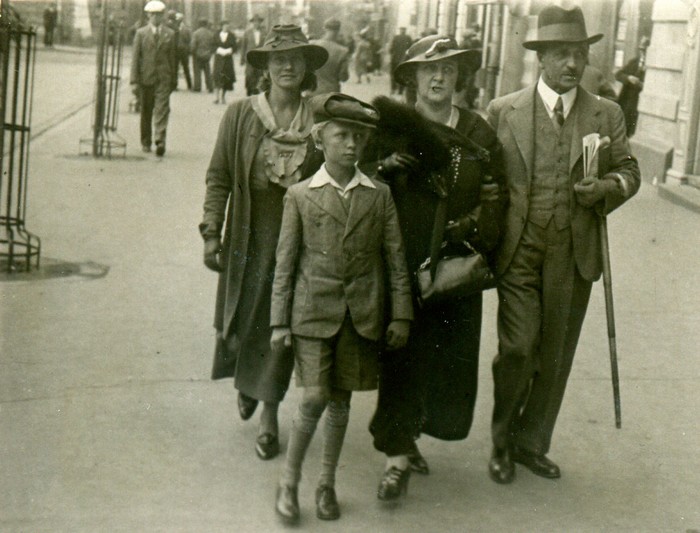
Marian Młynarski with his parents and nanny Wanda Wróblewska. Warsaw 1930.

Black and white photo of Marian with his parents and nanny during a walk in the city. The background of the photograph is of a street with passers-by. The boy is about ten years old and has light hair, obscured by a dark peaked cap. He is dressed in shorts, high socks and a shirt and blazer. Next to him walks his mother - Maria. She is middle-aged, with dark curls that are covered by a hat. She is dressed in an elegant black dress. In her hand she holds a black feather fan and a purse. Her husband, Felix holds her hand. The man is about forty years old with stubble and a mustache. He is dressed in a suit and hat and holds a newspaper and a walking stick in his hand. Following the family is Marian's nanny, Wanda Wroblewska. The woman is in her twenties, smiling slightly. She is dressed in a long sweater and dress and low-heeled shoes, with a hat on her head.
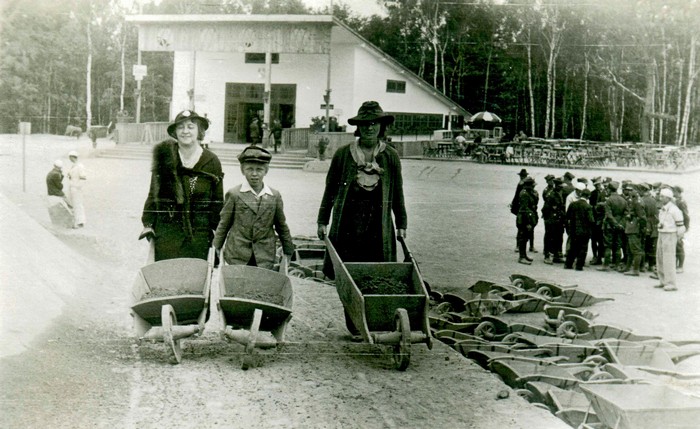
Marian Młynyraski with his mother and a nanny while building Piłsudski Mound. Kraków 1935.

Black and white photo of twelve-year-old Marian with his mother and nanny at the PilsudskiMound construction site. In the background is a white, single storey building, construction materials and a group of men talking to each other. The boy walks in the middle, dressed in a suit and a cassock. To his left is his mother, Maria, wearing a black dress with a fox fur coat on her shoulder and a hat on her head. To the boy's right is the nanny, dressed in a dress and long sweater and a hat. They are all pushing wheelbarrows in front of them.
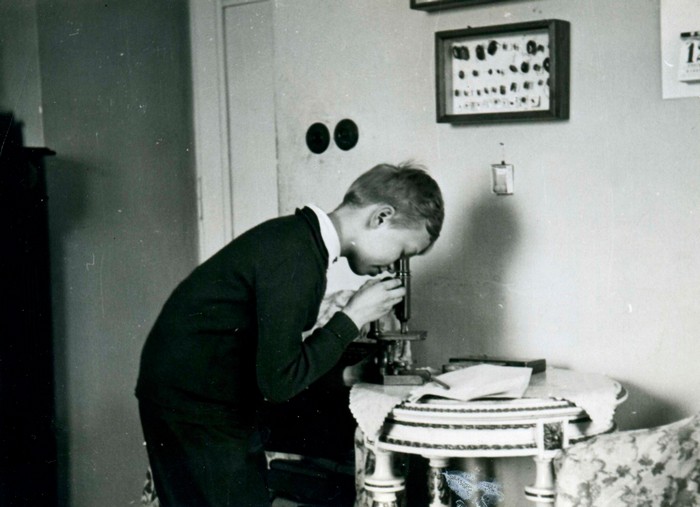
Marian Młynarski in 1935.

Black and white photo of twelve-year-old Marian in a room. The boy is wearing a shirt and a black sweater and pants. He is crouched over a white roundtable and looking into a microscope.

Bank Emisyjny in Kraków (today the National Bank of Poland). Photo: H. Hermanowicz. Property of the Historical Museum of the City of Kraków (MHK)

Black and white photo of the Seat of the Issuing Bank, now the National Bank of Poland. The photo was taken from the Barbican side, parallel to Basztowa Street. Mr. and Mrs. Mlynarski lived in the corner apartment during World War II.
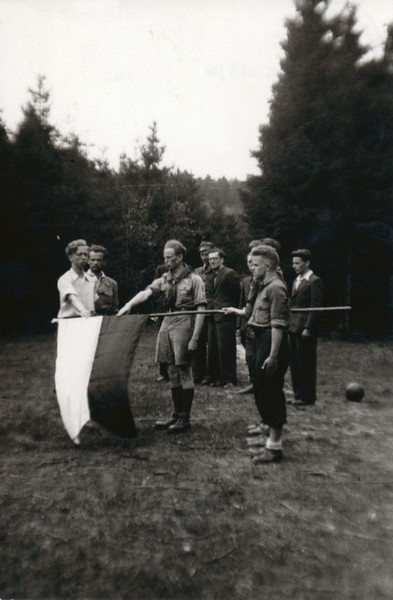
Scouts of Zawisza group taking an oath in Bętkowska Valley on Akanta clearing. April 23, 1944. From the left: Marian Młynarski, Edward Więcek, Kazimierz Lisiński, Mieczysław Mysiński.

A black-and-white photo of "Zawisza's" clandestine pledge in the I Będkowska Valley in the Akantaglade. The photograph shows nine teenagers. Behind them are low coniferous trees. The young men are dressed in scout uniforms. The scout in the center stands to attention and extends his hand towards a Polish flag held by a friend. The man in the white shirt to his right does the same.
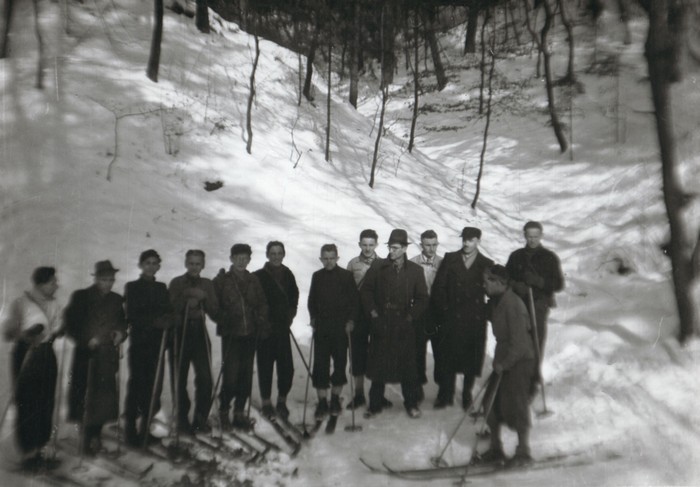
Zawisza group in Wolski Forest. February 20, 1944.

Black and white photo of a patrol run by the Kraków Zawisza in the Wolski forest. A group of thirteen young men stand in a row, almost all on skis. One of them is skiing in front of the row. There is a thick layer of snow all around.
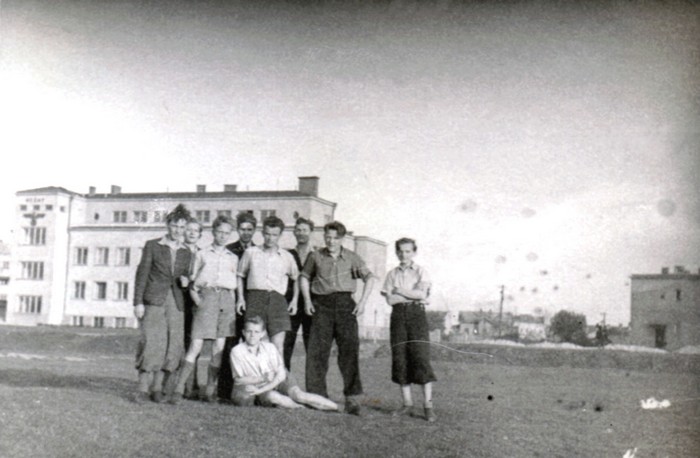
Zawisza group. May 17, 1944. From the left: A. Reuss, M. Młynarski, E. Więcek, J. Sajboth, J. Mysiński, M. Mysiński (seated).

Black and white photo of Zawisza team briefing at the Błonia. In the background is a bright townhouse. Eight teenagers in short-sleeved shirts and shorts or loose long pants. The boys stand in a group and pose for a photo, one of them is sitting on the grass in front of them.
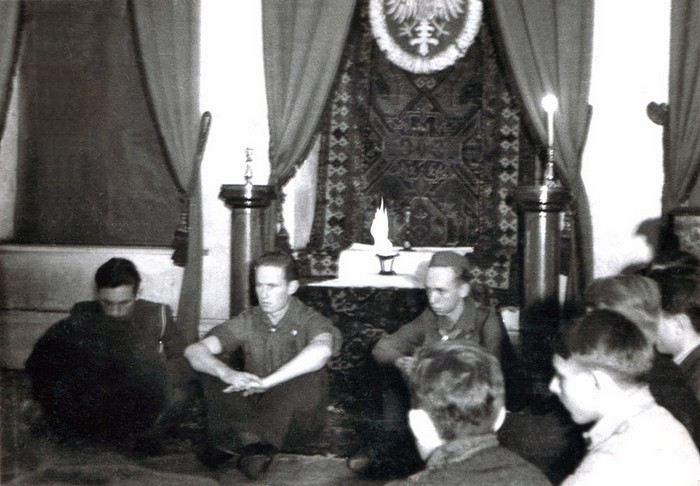
Zawisza scouts taking an oath. November 26, 1944. From the left: Adam Reuss, Kazimierz Lisiński, Marian Młynarski.

A black-and-white photo of Zawisza's underground pledge at the home of one of its members. The men are in a room behind tightly covered windows. Above the center against the carpet hangs the emblem of the Republic. The participants in the meeting are young men. They sit in a circle wearing scout uniforms. Marian Mlynarski - third from the left – is also wearing a beret.
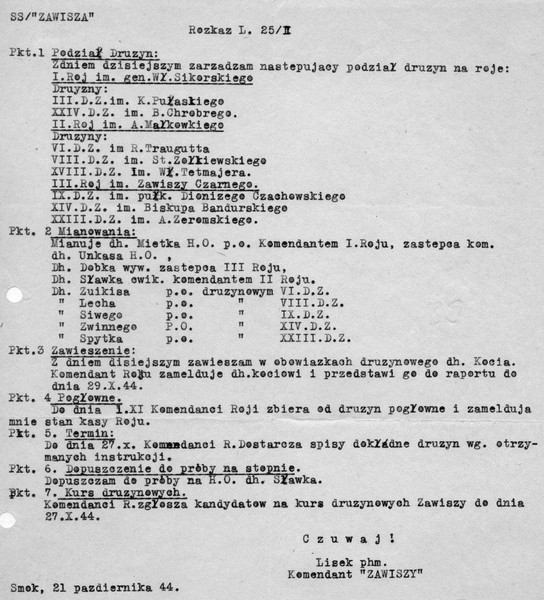
An order commanding to graduate Marian Młynarski to the rank of drużynowy (head) of Zawisza scout group. Kraków, Octorber 21, 1944. Property of the Historical Museum of the City of Kraków (MHK)

A scan of the order appointing Marian Mlynarski as team leader of the 6th Zawisza team in 1944. The document lists, among other things, the division of teams, appointments, and suspensions. The order was signed by Zawisza's Commander.

Railway Post Office. C. 1944. Property of the National Digital Archives (NAC)

Black and white photo of the Station Post Office, circa 1944. Sign "ZumBahnsteig 1" with an arrow to the right. Behind it is a building with stacks of sandbags leaning against its walls. In front of them is a cart loaded with a mountain of filled bags.
